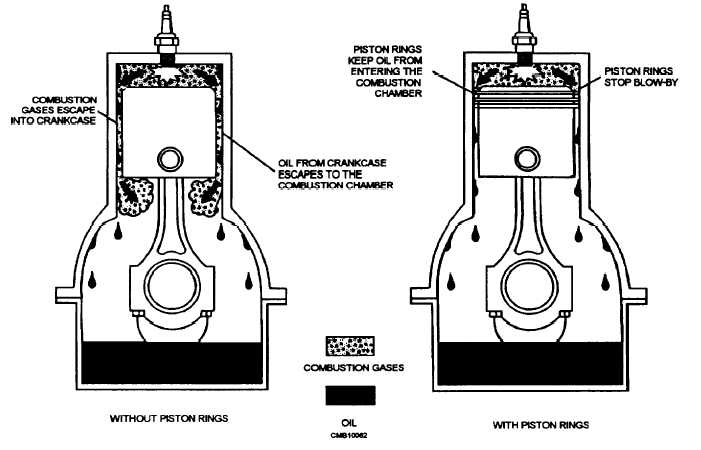An ANCHORED, or fixed, piston pin is locked into the piston pin bosses by a screw. The rod pivots freely on the connecting rod, which is fitted with a bronze bushing.
A SEMIFLOATING pin is locked to the connecting rod by a screw or by friction. The pin pivots freely in the piston pin bosses.
The FULL-FLOATING piston pin pivots freely in the connecting rod and piston pin bosses. The outer ends of the piston pins are fitted with lock rings to keep the pin from sliding out and contacting the cylinder walls.
Piston rings serve three important functions (fig. 3-31). They provide a seal between the piston and the cylinder wall to keep the force of the exploding gases from leaking into the crankcase from the combustion chamber. Blow-by is detrimental to engine performance because the force of the exploding gases merely bypasses the piston, rather than push down on it. It also contains the lubricating oil. They keep the lubricating oil from passing the piston and getting into the combustion chamber from the crankcase. Also, they provide a solid bridge to conduct heat from the piston to the cylinder wall. About one third of the heat absorbed by the piston passes to the cylinder wall through the piston rings.
Piston rings are secured to the piston by fitting into grooves. They are split to allow for installation and expansion, and they exert pressure on the cylinder walls when installed. They fit into grooves that are cut into the piston and are allowed to float freely in these grooves. A piston ring that is formed properly, working in a cylinder that is within limits for roundness and size, exerts an even pressure and a solid contact with the cylinder wall around the entire circumference. There are two basic classifications of piston rings. The COMPRESSION RING (fig. 3-32) that seals the force of the exploding mixture into the combustion chamber and the OIL CONTROL RING (fig. 3-32) that keeps engine lubricating oil from getting into the combustion chamber. These rings are arranged on the piston in three basic configurations (fig. 3-33). They are as follows:
The three-ring piston has two compression rings from the top, followed by one oil control ring—the most common configuration.

Figure 3-31.—Purpose of piston rings.
Continue Reading